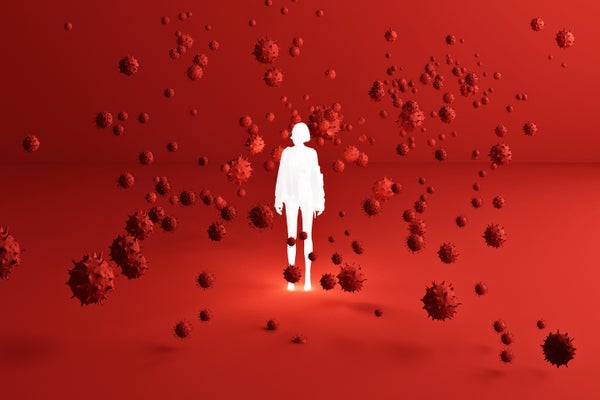Why Some People Haven’t Caught COVID despite Being Exposed
When scientists exposed people to the virus that causes COVID, only a subset got sick. Studying them could offer clues to immunity
Phiwath Jittamas/Getty Images
Not everyone who is exposed to SARS-CoV-2, the virus that causes COVID, gets the disease. New research published in June in Nature may partly explain why: In a 2021 experiment called a challenge study, researchers attempted to infect 16 unvaccinated volunteers with a low dose of the original strain of SARS-CoV-2. Participants who quickly squelched the virus activated a fast-acting innate immune response in their nose.
In the study, the team first assessed the participants’ baseline immune function and then spritzed an infectious solution into their nose. For four weeks afterward, the researchers collected nasal swabs and blood samples from the subjects for single-cell DNA sequencing analysis. This offered the scientists “an unprecedented view of what happens at the very early stage of viral exposure in humans,” says Akiko Iwasaki, an immunologist at the Yale School of Medicine, who was not involved in the study.
After inoculation, six of the 16 subjects developed a full-blown COVID infection, accompanied by mild symptoms such as a sore throat and nasal congestion. Three others tested positive or nearly positive in an on-and-off fashion, but had very mild or no symptoms. These individuals’ so-called transient infections were weak and short-lived. And the remaining seven participants resisted infection altogether, never testing positive.
On supporting science journalism
If you’re enjoying this article, consider supporting our award-winning journalism by subscribing. By purchasing a subscription you are helping to ensure the future of impactful stories about the discoveries and ideas shaping our world today.
The three people who fought off transient infections produced heavy doses of signaling proteins called interferons in their nose on day one after infection. In contrast, those who developed a full-blown infection showed interferons in their blood as early as day two but not in their nose until day five.
Interferons equip cells to defend against foreign invaders such as SARS-CoV-2: they momentarily halt major life functions that viruses hack into to replicate. A cell can produce interferon midway through an infection, before a virus has taken over its machinery, or it can trigger particular immune cells to produce the signal after it dies. Cells in the transiently infected group of participants sounded the body’s alarm before SARS-CoV-2 refashioned them into virus-making factories, warding off illness. The participants with a full-blown infection responded more slowly; once their body detected infection, it went into a panic that sent interferons everywhere. As a result, interferons reached the nose—the site of infection—later than they appeared in the bloodstream, giving the virus more time to multiply.
The idea that a powerful interferon response may help people suppress COVID is unlikely to surprise immunologists. The finding lines up with previous research that linked children’s relative resistance to COVID to their abnormally strong nasal innate immune responses and correlated higher levels of interferons in the blood to less severe disease. The new study underscores the important role interferons can play in defending against SARS-CoV-2 and the way that role varies throughout the body over the course of an infection.
Researchers do not yet understand why some people more quickly rally the innate immune system to fight off infection or how others totally repel the virus, but genetics may play a role. In the recent study, participants who snuffed out the virus relatively early or avoided infection tended to have high levels of baseline activity in a gene called HLA-DQA2. The gene produces a type of protein known to present immune cells with snippets of foreign invaders. It’s unclear whether the protein’s activity makes a person resilient to infection or is merely a product of an effective immune response, however. “We can’t really distinguish the chicken and the egg here,” says Rik Lindeboom, co-lead author of the study and a researcher at the Netherlands Cancer Institute.
How quickly an infected person pumps out interferons may not matter as much these days, when most people have already been infected with the virus or vaccinated against it, Iwasaki says. The body’s adaptive immune response—its slower, pathogen-specific defense—will likely come to the rescue if the innate response is slow. And some strains of the virus appear to have developed defense mechanisms against the interferon response, blunting its effect.
A case still remains for using interferon-boosting agents as a supplemental therapy, if timed well, Iwasaki notes. The challenge study makes clear that in order to effectively prevent infection, interferon levels must peak at or before day one. That means any potential drug would function best as a preventive measure—taken, say, before attending a concert—or as a “plan B” medication post-exposure. Some clinical trials have implemented these therapies past that time window, however, producing mixed results.
Companies could also use data from the infected participants to create better COVID vaccines, Lindeboom says. They could gauge their vaccines’ effectiveness by comparing the responses of immune cells called T cells to vaccination with the T cell responses seen in people who are recovering from COVID. And new nasal vaccines in development aim to block infection at the start by eliciting an adaptive immune response in the nose rather than the circulatory system.
Some people have interpreted the powerful capacity of the innate immune response as a reason to dismiss vaccines, he adds, but the response differs among individuals and cannot provide complete protection from the virus. Yet even mild COVID infections raise a person’s risk of heart problems and long COVID; widespread inflammation caused by a systemic immune response puts stress on the body’s organs.
The participants in the new study did not—thankfully—experience any long-term side effects, at least for up to one year post-exposure. But vaccination remains the most surefire way to limit both infection and long-term illness.




















Discussion about this post